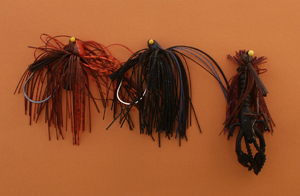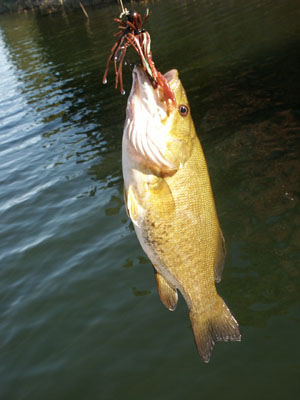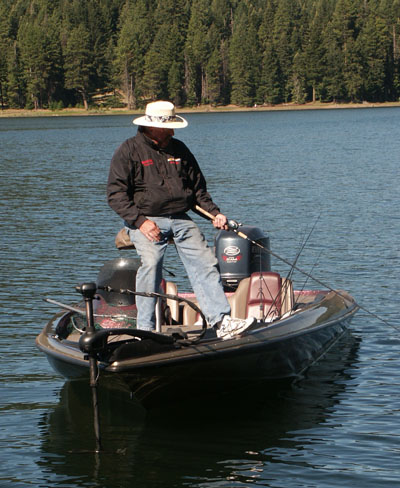
General information: The jig, regardless of its size, color or configuration, has one thing in common, and that is the hook has a molded lead head. The size of the hook and the size of the lead head determine whether a grub or a crawdad imitation will be attached. Jigs are best used in cold water in and around heavy cover. Some jigs come with wire weedguards so they are excellent choices for pitching or flipping throughout the seasons. Typically, a jig is fished vertically by lifting it off the bottom and then allowing it to fall back to the bottom. The jig can also be cast to a target and slowly worked up and down as it progresses back to the boat. Jigs may also be embellished with pork trailers.

Jig Hook Size: (6) 3/0, 4/0, 5/0 (photo)
Jig Skirts / Cover: deer hair; marabou (photos)
Common Jig Head Styles: (photos)
The round head is best suited for vertical jigging, but it does tend to ensnare grass and frequently gets caught in cover. The banana head affords more protection from hang-ups and works well in rock cover. The stand-up jig is designed to sink on the flat weight, while the hook rides upright. The stand-up jig is an excellent choice for attaching other baits. The flat-bottom helps keep the jig from slipping deep into weed cover. The football-head jig works well for weed retrievals, and it too is a good choice for attaching pork rind and other baits.
Ideal Water Temperature for Fishing a Jig: 50-60

Presentation: Traditional jigging simply lifts the jig of the bottom in a vertical rod lift, allowing the bait to pulsate down to the bottom. This method is also used to target suspended bass along steep cliffs or drop-offs. Another technique, which is similar to fishing the worm, is to slowly crawl the jig up and over structure, lifting and twitching the jig in a pattern of your choosing. Always be mindful of what you are doing when you get a strike. Make a notation on your fishing log. (Print a log here.)
Hook Set: Quick
Jigs: Grubs, Gitzits & Jigging Spoons
Grubs: (photo) Although grubs, attached to a jig, are excellent choices for cold, deep water fishing in heavy cover or structure, they work most efficiently during the summer and fall. Strikes often come during the grub’s fall, which are oftentimes difficult to detect. Raise the grub off the bottom one to two feet with a quick jerk upwards and allow the grub to twist and turn on its way back to the bottom. Successive repetitions, to renew the jigging process, often sets the hook on a bass that unbeknownst to you had softly sucked in the grub! Light lines on spinning rods work best.
Gitzits (Tube Baits): (photo) Gitzits or tube baits are my favorite plastic bait along with Senko worms. Every beginning bass angler should have many of these baits in multiple sizes and colors. Originally developed by Bobby Garland and his brother Garry over thirty years ago, the Gitzit is a tube bait attached to a lead-head jig. I have had great success fishing smaller tube baits for smallmouth bass on slow moving California rivers, such as the Stanislaus River. Although spinning reels with 8-10 weight lines are most recommended, my favorite method for fishing these baits is with a fly rod “casting” downstream from a kick boat. (Click here to learn more about Fly Roddin’ for bass.)
Use the same jigging techniques as mentioned above as well as the slow crawl--pause technique. Flipping is a popular presentation using a drop-shot or rigging the tube Carolina style. Although most experts dissuade rigging the tube Texas style, I have found that when fishing for smallmouth in current with, my best results were with a Texas rigging. The number of missed strikes pales in comparison to hang-ups in current.
Recommended Links for tube bait fishing:
Bassresource.com provides an excellent review of tube fishing from a pro.
Recommended Videos: If you have never fished with tube baits, buy the video Gitsits with the Garland Brothers, a Bazz Clazz video. Read my review on the Gitzit tape. If I had a 5-Star rating system, this one would deserve 5 Stars!
Jigging Spoons: Jigging spoons, usually in silver and gold, are favorites for suspended bass on steep drop-offs. Be sure to use a weedless model in heavy structure. Weedless jigging spoons are also popular when fishing gunk. Cast the lure on top of the weeds or moss, pause, and then slowly crawl the spoon to a small opening and allow the spoon to sink to the bottom before you begin jigging. Be attentive as a bass may take the spoon on the fall to the bottom.
Recommended Links for Jigging Spoons:
Jig and Pig: For as long as anglers have been using lead-head jigs, they have been garnishing these fish catchers with pork rind to simulate crawfish. This combination is best utilized in colder water for larger fish. One such popular product is Uncle Josh’s pork frog and little crawdad. Keep in mind that during the spring female bass, especially smallmouth bass, gorge themselves on crawdads. So a Jig and Pig in crawdad colors or crawdad lures work especially well during this pre-spawn period when the females bulk up in preparation fo the spawn.
Jig and Pig Fishing Articles
http://www.tackletour.com/reviewunclejoshjig.html
One of the best on-line articles on jigs is written by Russ Bassdozer; this jig fishing article also includes links to other great articles on jigging.
Bassresource.com provides a short but sweet review of jig fishing.









